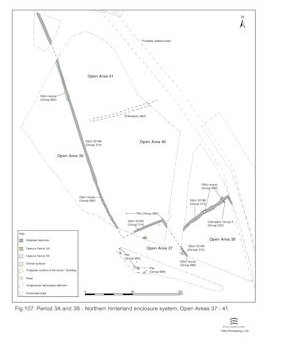
Probably as part of the same mid-2nd century episode of maintenance or reinstatement of the northern hinterland enclosure system, earlier ditches 25199, 25194, 25188 and 25190 are all subject to re-cutting (Figure 107). Overall, the boundary system imposed in Period 2B is perpetuated. However, subtle modifications seem to mark the beginning of more substantial mid-Roman period change.

Excavated segments 418, 422, 465, 553 constitute a series of re-cuts along infilled Period 2B-3 ditch 25188. These do not necessarily form a single continuous cut but may be a number of ad hoc partial cleanings undertaken to perpetuate its line, but are combined here as 25273, for ease of reference. The individual segments are all between 2-3m wide and around 0.5m deep and largely contain silting deposits. The fills of 418 and 553 are of mid-2nd century AD date, while the late 3rd to 4th century AD date for segment 465 perhaps shows that the boundary is maintained for a protracted period of time before being allowed to fill.
Period 2B-3 ditch 25190 also contains likely irregular re-cut 25274 (segs 401, 568, 638), suggesting that the whole of the 1st-century system of land division created in the Late Iron Age is maintained throughout the early Roman period and beyond. 25190 is particularly notable for the occurrence of two placed deposits (in segs 401 and 568), each comprising a pair of jars with perforated bases (see also Vol. 1, Chapter 6). The production of these vessels is dated to the late 1st to early 2nd century, though they could be deposited later. The fills of further excavated segment 638 includes ceramics of late 2nd/mid-3rd century date which, like 25273, may suggest the continuance of this boundary into Period 4.
Ditches 25103 (segs 2312, 2355, 2879, 2936) and 25105 (segs 2274, 2308, 2310, 2314, 2437) are re-cuts of the major Period 2B boundary ditch 25199, which largely silts up during the late 1st and early 2nd centuries AD. The line of this boundary is perpetuated or re-instated, around the mid-2nd century AD, by the excavation of what amounts to a pair of shallow re-cuts in its top. These do not retain the full length of the original ditch, but introduce a 45m-wide gap, approximately in the middle of its exposed length. This clearly constitutes a point of access between the fields either side of the boundary (OAs 39 and 40/41), as perhaps emphasised by the subsequent siting of a crop-processing structure adjacent to each terminal (i.e. corn-dryers 2338 and 3014) in Period 4. The lengths of re-cut ditch are relatively shallow. The gravelly nature and angle of accumulation of their fills suggests they are flanked by a gravel bank.
This practice of maintaining the boundary by means of the excavation of multiple lengths of shallow re-cut ditches seems to continue as late as the 4th century AD, as denoted by the presence of post-Period 3 material in segments 2308 and 2312. It is clear that this ditch line is continuously used throughout the Roman period and cannot be dated simply by reference to its latest fills.
Internet Archaeology is an open access journal based in the Department of Archaeology, University of York. Except where otherwise noted, content from this work may be used under the terms of the Creative Commons Attribution 3.0 (CC BY) Unported licence, which permits unrestricted use, distribution, and reproduction in any medium, provided that attribution to the author(s), the title of the work, the Internet Archaeology journal and the relevant URL/DOI are given.
Terms and Conditions | Legal Statements | Privacy Policy | Cookies Policy | Citing Internet Archaeology
Internet Archaeology content is preserved for the long term with the Archaeology Data Service. Help sustain and support open access publication by donating to our Open Access Archaeology Fund.